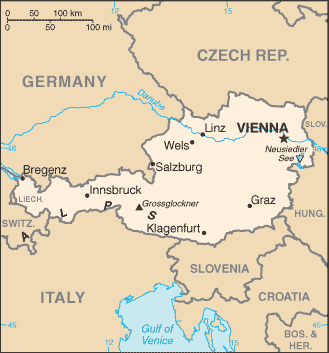|
Austria
|

|
Capital: Vienna
Population: 8,955,102
Brief History of Austria:
The area that is today Austria was occupied by Celtic tribes for much of its early history until it was conquered by the Roman Empire. With the fall of the Roman Empire, the region once again was ruled by local tribes until 788 when it was conquered by Charlemagne. The region became known as Austria in 976 when it was ruled by Leopold of Babenberg.
In 1276, Rudolf I became the first Habsburg to rule Austria. This was the start of the Habsburg Empire which would rule Austria for the next 750 years. The Habsburgs began to grow the empire well beyond the current borders of Austria, making Austria a center for power in Europe for many centuries.
In 1848 Franz Josef I became the Habsburg ruler and would rule for nearly 70 years until 1916 when he died. Franz Josef made many changes in Austria. One thing he did was to give more power to Hungary by creating what was later called the Dual Monarchy. This began the fall of the Hapsburg domination. Later in 1919, after World War I, the empire collapsed and the Austrian Republic was created by the Treaty of St. Germain.
In 1938 Austria was annexed into Germany as part of WWII. Most of Austria's Jewish population was killed or forced to leave in the holocaust. This went on until the war was over in 1945. Austria was divided up after the war and did not become a fully independent country again until a treaty was signed in Vienna on October 25, 1955.
The Geography of Austria
Total Size: 83,870 square km
Size Comparison: slightly smaller than Maine
Geographical Coordinates: 47 20 N, 13 20 E
World Region or Continent: Europe
General Terrain: in the west and south mostly mountains (Alps); along the eastern and northern margins mostly flat or gently sloping
Geographical Low Point: Neusiedler See 115 m
Geographical High Point: Grossglockner 3,798 m
Climate: temperate; continental, cloudy; cold winters with frequent rain and some snow in lowlands and snow in mountains; moderate summers with occasional showers
Major cities: VIENNA (capital) 1.693 million (2009), Graz, Linz
The People of Austria
Type of Government: federal republic
Languages Spoken: German (official nationwide), Slovene (official in Carinthia), Croatian (official in Burgenland), Hungarian (official in Burgenland)
Independence: 17 September 1156 (Duchy of Austria founded); 11 August 1804 (Austrian Empire proclaimed); 12 November 1918 (republic proclaimed)
National Holiday: National Day, 26 October (1955); note - commemorates the State Treaty restoring national sovereignty and the end of occupation and the passage of the law on permanent neutrality
Nationality: Austrian(s)
Religions: Roman Catholic 73.6%, Protestant 4.7%, Muslim 4.2%, other 3.5%, unspecified 2%, none 12% (2001 census)
National Symbol: black eagle
National Anthem or Song: Bundeshymne (Federal Hymn)
Economy of Austria
Major Industries: construction, machinery, vehicles and parts, food, metals, chemicals, lumber and wood processing, paper and paperboard, communications equipment, tourism
Agricultural Products: grains, potatoes, sugar beets, wine, fruit; dairy products, cattle, pigs, poultry; lumber
Natural Resources: oil, coal, lignite, timber, iron ore, copper, zinc, antimony, magnesite, tungsten, graphite, salt, hydropower
Major Exports: machinery and equipment, motor vehicles and parts, paper and paperboard, metal goods, chemicals, iron and steel, textiles, foodstuffs
Major Imports: machinery and equipment, motor vehicles, chemicals, metal goods, oil and oil products; foodstuffs
Currency: euro (EUR)
National GDP: $349,900,000,000
** Source for population (2012 est.) and GDP (2011 est.) is CIA World Factbook.
Back to Geography Home Page
